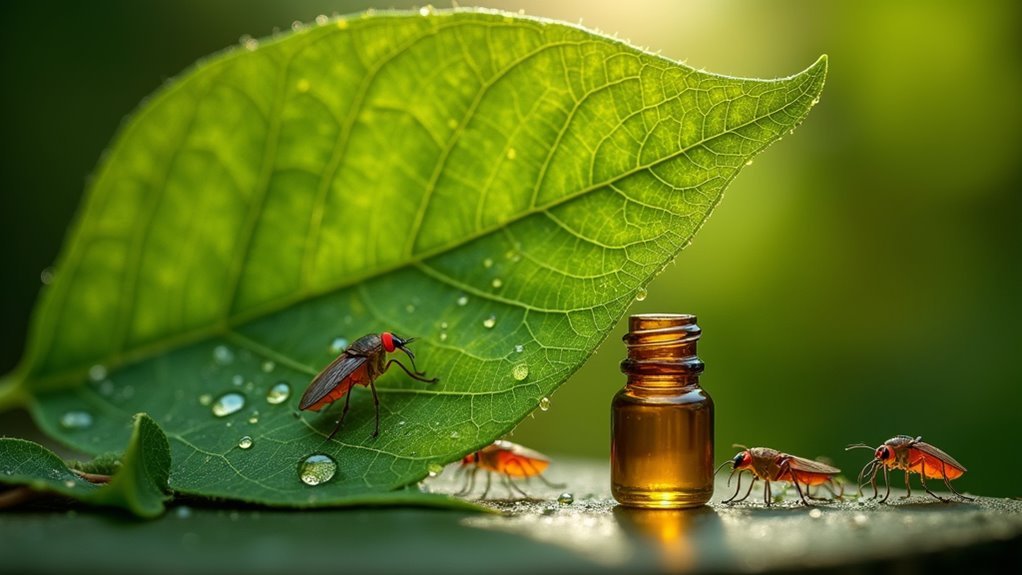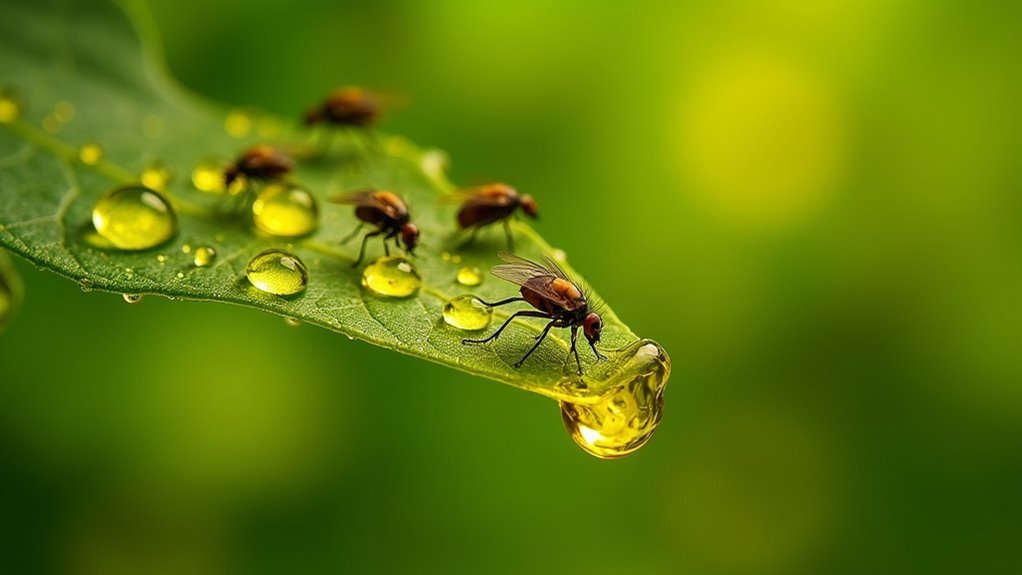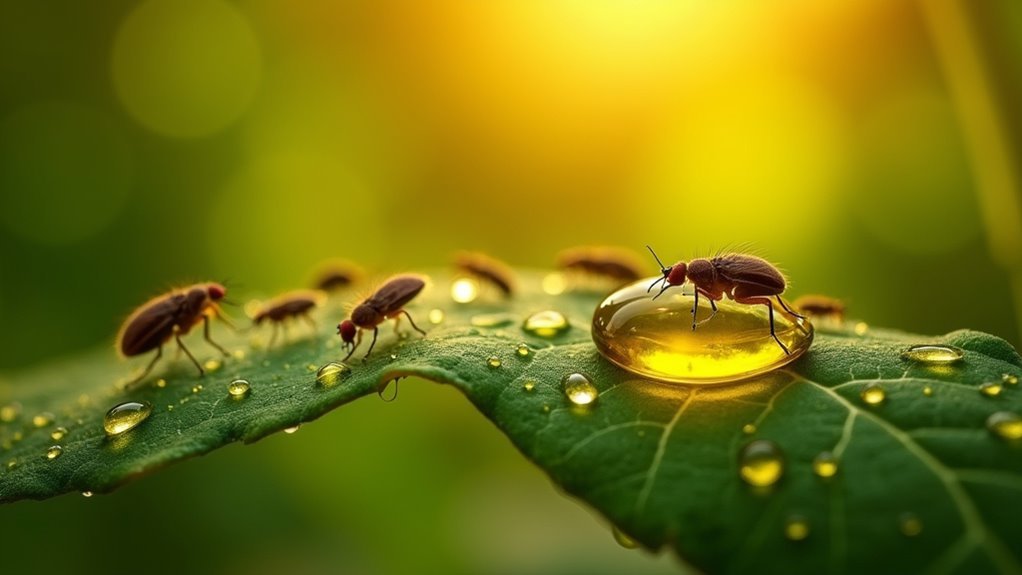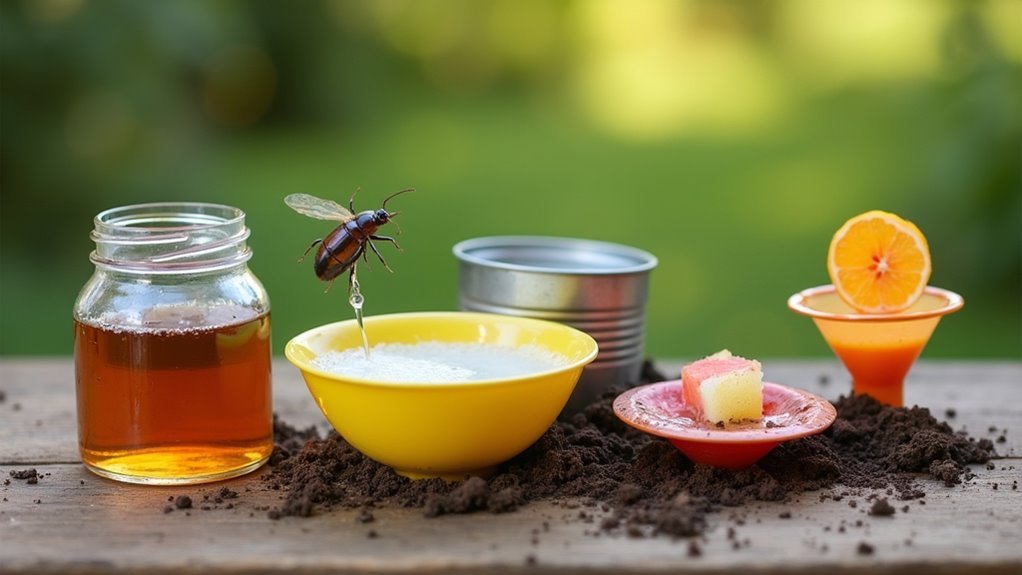Neem oil’s effectiveness against fleas comes from azadirachtin, a compound that disrupts your pet’s flea problem at multiple levels. It sterilizes adult fleas, prevents eggs from hatching, and blocks larvae development into reproducing adults. You’ll see immediate reduction in flea activity as it interferes with their feeding and destroys their exoskeletons. This multi-target approach makes resistance virtually impossible while remaining safe for your pets. Understanding proper application timing and concentration will maximize these powerful anti-flea properties.
Understanding Azadirachtin’s Role in Flea Control

When battling stubborn flea infestations, azadirachtin emerges as neem oil’s most powerful weapon against these persistent pests. This natural insect growth regulator disrupts fleas’ hormonal processes, preventing them from maturing and reproducing effectively.
You’ll find that azadirachtin interferes with adult fleas’ feeding ability, causing starvation and death.
What makes this compound particularly effective is its all-encompassing approach. It doesn’t just target adult fleas—it also inhibits larvae and egg development, reducing the entire population.
Studies have documented azadirachtin’s effectiveness in controlling infestations while preserving beneficial insects.
Unlike conventional chemical insecticides, this biodegradable compound breaks down quickly in the environment, minimizing ecological impact.
You’re getting powerful pest control without harming the ecosystem around your home.
How Neem Oil Disrupts the Flea Life Cycle
To truly understand neem oil’s effectiveness against fleas, you need to examine how it systematically dismantles their reproductive cycle at every stage.
Neem oil’s active compound, azadirachtin, prevents flea eggs from hatching while simultaneously blocking larvae from developing into adults. This dual action creates a powerful interruption in the flea’s natural progression.
When you apply neem oil to your pets, it targets the central nervous system of existing fleas, severely impairing their reproductive capabilities.
Since flea cycles can complete in just one week during warm weather, this disruption becomes critically important for population control.
Regular neem oil applications maintain consistent pressure on immature fleas, preventing them from reaching reproductive maturity and effectively breaking the cycle that allows infestations to persist.
Natural Insecticidal Properties of Neem Extract

Beyond disrupting reproductive cycles, neem extract possesses remarkable insecticidal properties that make it a formidable natural weapon against fleas.
You’ll find that neem oil’s antimicrobial and antiparasitic compounds work systematically against all flea life stages, from eggs to adults. The oil doesn’t just kill existing fleas—it creates an inhospitable environment that prevents new infestations.
When you apply neem oil, its potent odor acts as a powerful deterrent, repelling fleas before they can establish themselves on your pet or in your home.
The extract’s natural compounds penetrate flea exoskeletons, disrupting their cellular functions and causing mortality. Unlike synthetic pesticides, neem oil’s multiple active components make it difficult for fleas to develop resistance, ensuring consistent effectiveness over time.
Neem Oil’s Impact on Flea Reproduction and Development
While fleas reproduce rapidly under normal conditions, neem oil’s azadirachtin compound targets their hormonal systems with surgical precision, fundamentally sterilizing entire populations before they can establish themselves.
You’ll find that azadirachtin disrupts the flea’s developmental process, preventing larvae from maturing into reproducing adults and breaking their life cycle at multiple stages.
When you apply neem oil consistently, you’re effectively deploying an insect growth regulator that blocks developmental progression. The compound prevents flea eggs from hatching while simultaneously stopping existing larvae from progressing.
Studies demonstrate that regular neem oil application achieves a 90% reduction in flea reproduction rates.
This dual-action approach means you’re not just killing existing fleas—you’re preventing future generations from emerging, creating long-term population control.
Why Fleas Cannot Build Resistance to Neem Oil

Unlike synthetic pesticides that target single biological pathways, neem oil’s complex molecular structure attacks fleas through multiple mechanisms simultaneously, making resistance development virtually impossible.
Here’s why fleas can’t adapt to neem oil:
- Multi-target approach – Azadirachtin disrupts both nervous and reproductive systems, preventing fleas from developing counter-mechanisms to a single pathway.
- Biodegradable nature – The oil breaks down quickly in your environment, so fleas don’t encounter consistent concentrations needed for adaptation.
- Life cycle interruption – Regular applications prevent fleas from completing their developmental stages, eliminating opportunities for resistant traits to emerge.
- Natural complexity – Unlike synthetic chemicals, neem oil contains multiple active compounds that work together, making it impossible for fleas to evolve resistance to all components simultaneously.
This multi-faceted approach guarantees long-term effectiveness without compromising your pet’s safety.
The Science Behind Neem’s Insect Growth Regulation
You’re witnessing a sophisticated biological warfare when neem oil’s azadirachtin targets flea development at the cellular level.
This compound doesn’t just kill fleas—it interferes with their hormonal systems, preventing larvae from molting properly and blocking their transformation into adults.
The result is a complete breakdown of the reproductive cycle, where eggs can’t develop and existing fleas can’t produce viable offspring.
Azadirachtin Disrupts Development
When fleas encounter neem oil, azadirachtin—the compound’s most potent active ingredient—launches a sophisticated biological assault on their developmental machinery. This natural insect growth regulator targets the hormonal processes that fleas depend on for survival and reproduction.
Azadirachtin disrupts flea development through four key mechanisms:
- Chitin synthesis inhibition – Prevents larvae from forming proper exoskeletons needed for maturation.
- Reproductive interference – Reduces egg production, causing population decline over time.
- Life cycle extension – Forces flea eggs to fail hatching or develop improperly.
- Hormonal disruption – Blocks essential growth hormones required for normal development.
Studies demonstrate azadirachtin’s remarkable effectiveness, reducing flea populations by up to 90% with consistent application, making it a powerful natural pest control solution.
Hormonal System Interference
The mechanisms we’ve explored represent just the surface of azadirachtin’s biological warfare against fleas.
When you apply neem oil, azadirachtin targets the endocrine system that controls insect development. It mimics natural hormones, confusing the flea’s regulatory processes and preventing normal molting between life stages.
This hormonal disruption doesn’t just affect development—it devastates adult fleas’ reproductive capabilities. The compound interferes with hormone production necessary for egg development and fertility, causing significant population decline over successive generations.
You’ll notice fewer fleas appearing as the treatment breaks their breeding cycle.
Additionally, azadirachtin attacks the central nervous system, causing disorientation and coordination problems that lead to death.
This multi-pronged hormonal assault makes neem oil particularly effective in warm climates where flea reproduction accelerates rapidly.
Reproductive Cycle Breakdown
Beyond disrupting hormone production, azadirachtin systematically dismantles the flea’s reproductive machinery at every developmental stage.
When you apply neem oil consistently, you’re targeting the entire life cycle with surgical precision.
The reproductive breakdown occurs through four critical stages:
- Egg Prevention – Azadirachtin prevents viable egg formation, cutting reproduction at its source.
- Larval Disruption – Active compounds halt larvae from progressing to the pupal stage.
- Adult Sterility – Mature fleas can’t produce fertile offspring after exposure.
- Cycle Interruption – The shortened one-week reproductive cycle gets completely derailed.
This cumulative effect means you’re not just killing existing fleas—you’re preventing future generations.
Each application builds upon the previous one, creating a compounding impact that gradually eliminates the entire population through reproductive failure.
Comparing Neem Oil to Chemical Flea Treatments
Although chemical flea treatments dominate pet stores and veterinary offices, neem oil offers a compelling natural alternative that works differently than conventional pesticides. While chemicals deliver immediate knockdown effects, neem oil targets the reproductive cycle for long-term control.
| Feature | Chemical Treatments | Neem Oil |
|---|---|---|
| Speed | Kills adult fleas immediately | Slower action, targets lifecycle |
| Safety | Potential toxicity risks | Safer for pets and humans |
| Environment | Harms beneficial insects | Biodegradable, eco-friendly |
You’ll find that neem oil requires consistent application to maintain effectiveness, unlike one-time chemical treatments. However, its azadirachtin compound disrupts flea development naturally without environmental harm. For severe infestations, you might need combining both approaches to achieve ideal results while minimizing chemical exposure.
Essential Compounds That Make Neem Oil Potent
When you apply neem oil to combat fleas, you’re harnessing the power of specific bioactive compounds that work together to eliminate these pests.
The oil’s primary weapon is azadirachtin, a triterpene that doesn’t just repel fleas but actively disrupts their reproductive cycles and targets their nervous systems.
These natural growth regulators prevent flea larvae from reaching maturity, breaking the infestation cycle at multiple stages.
Azadirachtin Disrupts Reproduction
Since neem oil’s effectiveness against fleas stems largely from its active compounds, azadirachtin stands out as the most potent weapon in this natural arsenal. This remarkable compound disrupts the hormonal systems of insects, preventing their ability to mature and reproduce successfully.
Azadirachtin’s reproductive disruption works through:
- Hormonal interference – blocks normal development signals in flea larvae
- Growth regulation – prevents larvae from maturing into breeding adults
- Reproductive shutdown – reduces flea reproduction rates by up to 90%
- Life cycle disruption – effectively breaks the continuous flea breeding cycle
You’ll find azadirachtin functions as a natural insect growth regulator, targeting the central nervous system while preserving beneficial insects.
This targeted approach makes it incredibly effective at controlling infestations by stopping future generations before they can establish themselves.
Triterpenes Target Nervous System
While azadirachtin gets most of the attention, neem oil’s triterpenes work as a thorough attack system that targets fleas’ nervous systems through multiple pathways.
These natural compounds don’t just kill fleas—they completely disrupt their biological processes. When you apply neem oil, triterpenes interfere with the hormones controlling molting and reproduction, creating chaos in fleas’ developmental cycles.
The nervous system disruption prevents larvae from successfully maturing into breeding adults, breaking the infestation cycle at its source. You’ll notice fewer fleas over time because these compounds render existing populations unable to reproduce effectively.
Additionally, triterpenes create that distinctive strong odor that repels new fleas from settling on your pet, providing both treatment and prevention in one application.
Growth Regulators Prevent Maturation
Because neem oil’s growth regulators target fleas during their most vulnerable developmental stages, they create a powerful disruption that prevents larvae from ever reaching reproductive maturity.
Azadirachtin serves as the primary active compound responsible for this interference, fundamentally altering how young fleas develop within your environment.
When you apply neem oil consistently, you’ll create conditions that systematically break down flea populations through these mechanisms:
- Developmental arrest – Larvae can’t progress between growth stages
- Hormonal disruption – Natural molting processes become impossible
- Reproductive interference – Any surviving fleas can’t produce viable offspring
- Population collapse – Studies show significant reduction within one week
This growth regulation approach means you’re not just killing existing adult fleas – you’re preventing future generations from establishing themselves in your space.
How Neem Oil Affects Adult Fleas vs. Larvae
Although neem oil affects both adult fleas and their larvae, it works through different mechanisms at each life stage. When you apply neem oil to treat adult fleas, you won’t see immediate knockdown effects like with traditional insecticides. Instead, the azadirachtin in neem oil disrupts their reproductive cycle, preventing them from laying viable eggs and stopping future generations from developing.
The impact on larvae is more direct and lethal. Neem oil interferes with larval growth and development, causing them to die before they can mature into biting adults.
This dual-action approach means you’re targeting both existing adult populations and preventing new ones from emerging. While adults may survive initial treatment, their reproductive capabilities become severely compromised, leading to gradual population decline over successive treatments.
Proper Concentration Levels for Maximum Effectiveness
Getting the concentration right determines whether your neem oil treatment will effectively control fleas without harming your pet.
Proper neem oil concentration is the key to safe, effective flea control that protects your pet from harm.
Most veterinarians recommend keeping neem oil concentrations at no more than 1% for safe application on pets. Higher concentrations can cause skin irritation and adverse reactions, making proper dilution critical.
For maximum effectiveness, follow these proper concentration levels:
- Mix at 1:10 ratio – Combine one part neem oil with ten parts carrier oil or pet shampoo
- Ensure high-quality neem oil – Use products with sufficient azadirachtin concentration for flea control
- Apply weekly or bi-weekly – Regular treatments interrupt the flea life cycle effectively
- Test small areas first – Check for skin sensitivity before full application
This balanced approach delivers effective flea management while protecting your pet’s health.
Duration and Persistence of Neem Oil’s Anti-Flea Action
You’ll need to understand how long neem oil remains active against fleas to plan your treatment schedule effectively.
The oil’s anti-flea properties typically persist for one to two weeks, but this timeline varies based on how quickly your pet’s skin absorbs the treatment and environmental conditions like temperature and humidity.
You’ll achieve the best results by reapplying neem oil weekly or bi-weekly, especially during warm weather when fleas reproduce more rapidly and the oil breaks down faster.
Oil Absorption Timeline
When you apply neem oil to your pet’s coat or around your home, the active compound azadirachtin starts working within minutes to disrupt flea development and reproduction.
The absorption process follows a predictable timeline that determines treatment effectiveness.
Understanding neem oil’s absorption helps you optimize application timing:
- Initial contact (0-5 minutes) – Azadirachtin begins penetrating flea exoskeletons and disrupting their hormonal systems.
- Peak absorption (15-30 minutes) – Maximum compound uptake occurs, ensuring thorough coverage of treated areas.
- Sustained release (1-7 days) – Active ingredients continue working until environmental factors or washing removes residues.
- Biodegradation (24 hours in water) – Natural breakdown prevents harmful accumulation while maintaining targeted effectiveness.
This timeline explains why you’ll notice immediate flea activity reduction, with continued protection lasting up to one week depending on conditions.
Reapplication Frequency Requirements
Effective flea control with neem oil demands consistent reapplication every 1-2 weeks to maintain its insect growth-regulating properties.
Since flea life cycles can complete in just one week during warm weather, you’ll need weekly treatments to disrupt reproduction effectively.
While neem oil won’t kill mature fleas instantly, it prevents them from reproducing when applied consistently.
You should continue treatments until the infestation resolves completely.
The persistent presence of neem oil creates an environment that controls flea populations and prevents reinfestation.
Combine your neem oil applications with regular vacuuming and thorough cleaning of pet bedding to enhance effectiveness.
This integrated approach prolongs the duration of anti-flea action and guarantees better control of both pet and home environment flea problems.
Environmental Breakdown Rate
Neem oil’s environmental breakdown rate considerably impacts its anti-flea effectiveness, with the compound degrading within 24 hours under normal conditions. This rapid degradation creates both advantages and challenges for flea control strategies.
The quick breakdown offers several key benefits:
- Minimal environmental persistence – Neem oil won’t accumulate in soil or water systems.
- Safe for ecosystems – Biodegradability prevents long-term environmental contamination.
- Reduced chemical buildup – No toxic residue remains around your home or garden.
- Family-friendly application – Safe for areas where children and pets play.
However, you’ll need consistent reapplication since the active ingredient azadirachtin loses potency quickly.
While studies show effectiveness can last several days post-application, regular treatment schedules guarantee continuous flea population control without environmental concerns.
Environmental Factors That Enhance Neem Oil Performance
While neem oil provides natural flea control on its own, several environmental factors can greatly boost its performance against these persistent pests.
Timing your application strategically maximizes effectiveness. You’ll get better results during spring and summer when flea activity peaks, allowing neem oil to disrupt their reproductive cycle. Apply during cooler parts of the day since sunlight degrades the active compounds.
| Environmental Factor | Best Conditions | Impact on Effectiveness |
|---|---|---|
| Temperature/Humidity | Warm, humid weather | Accelerates flea lifecycle for targeted intervention |
| Light Exposure | Early morning/evening | Prevents compound degradation |
| Combined Treatments | Clean environment + diatomaceous earth | Creates thorough multi-stage flea control |
Prepare your pet’s environment by vacuuming thoroughly to remove eggs and larvae, then combine neem oil with diatomaceous earth for thorough coverage across all flea life stages.
Frequently Asked Questions
Does Neem Oil Actually Kill Fleas?
Neem oil doesn’t directly kill fleas, but you’ll find it disrupts their life cycle and nervous system. It prevents reproduction and maturation while repelling adults, effectively reducing populations over time with consistent application.
How to Dilute Neem Oil for Fleas?
You’ll want to dilute neem oil to 1% concentration by mixing one part neem oil with ten parts carrier oil or shampoo. For sprays, combine 5ml neem oil with one liter water.
What if a Dog Licks Neem Oil?
If your dog licks neem oil, watch for vomiting or diarrhea. Contact your vet if symptoms appear. You should prevent licking by applying oil where they can’t reach it.
What Does Neem Oil Not Kill?
You’ll find neem oil doesn’t kill flea eggs, pupae, heartworms, or certain tick species. It won’t eliminate resistant flea strains and doesn’t eradicate internal parasites, as it primarily repels rather than kills.
In Summary
You’ve now seen how neem oil’s azadirachtin compound disrupts every stage of the flea lifecycle, from preventing reproduction to breaking down their feeding patterns. You can’t go wrong choosing this natural solution since fleas can’t develop resistance to it. When you apply the proper concentration consistently and consider environmental factors, you’ll effectively eliminate both adult fleas and larvae without exposing your family or pets to harsh synthetic chemicals.





Leave a Reply